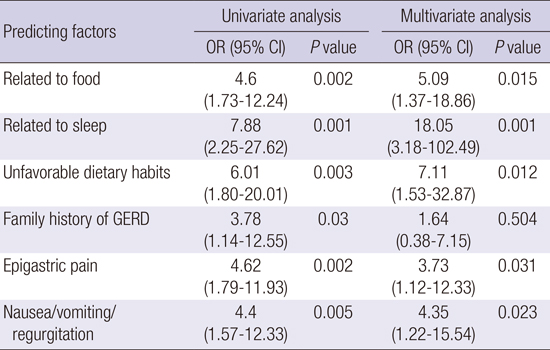1. Eslick GD, Jones MP, Talley NJ. Non-cardiac chest pain: prevalence, risk factors, impact and consulting--a population-based study. Aliment Pharmacol Ther. 2003; 17:1115–1124.
2. Danduran MJ, Earing MG, Sheridan DC, Ewalt LA, Frommelt PC. Chest pain: characteristics of children/adolescents. Pediatr Cardiol. 2008; 29:775–781.
3. Geggel RL. Conditions leading to pediatric cardiology consultation in a tertiary academic hospital. Pediatrics. 2004; 114:e409–17.
4. Shrestha S, Pasricha PJ. Update on noncardiac chest pain. Dig Dis. 2000; 18:138–146.
5. Kim JH, Rhee PL, Park EH, Son HJ, Kim JJ, Rhee JC. Clinical usefulness of subgrouping of patients with non-cardiac chest pain according to characteristic symptoms in Korea. J Gastroenterol Hepatol. 2007; 22:320–325.
6. Richter JE. Chest pain and gastroesophageal reflux disease. J Clin Gastroenterol. 2000; 30:S39–41.
7. Mousavi S, Tosi J, Eskandarian R, Zahmatkesh M. Role of clinical presentation in diagnosing reflux-related non-cardiac chest pain. J Gastroenterol Hepatol. 2007; 22:218–221.
8. Karlaftis A, Karamanolis G, Triantafyllou K, Polymeros D, Gaglia A, Triantafyllou M, Papanikolaou IS, Ladas SD. Clinical characteristics in patients with non-cardiac chest pain could favor gastroesophageal reflux disease diagnosis. Ann Gastroenterol. 2013; 26:314–318.
9. Evangelista JA, Parsons M, Renneburg AK. Chest pain in children: diagnosis through history and physical examination. J Pediatr Health Care. 2000; 14:3–8.
10. Friedman KG, Kane DA, Rathod RH, Renaud A, Farias M, Geggel R, Fulton DR, Lock JE, Saleeb SF. Management of pediatric chest pain using a standardized assessment and management plan. Pediatrics. 2011; 128:239–245.
11. Okimoto E, Ishimura N, Morito Y, Mikami H, Shimura S, Uno G, Tamagawa Y, Aimi M, Oshima N, Kawashima K, et al. Prevalence of gastroesophageal reflux disease in children, adults, and elderly in the same community. J Gastroenterol Hepatol. 2015; 30:1140–1146.
12. Thrift AP, Kramer JR, Qureshi Z, Richardson PA, El-Serag HB. Age at onset of GERD symptoms predicts risk of Barrett’s esophagus. Am J Gastroenterol. 2013; 108:915–922.
13. Balasubramanian G, Singh M, Gupta N, Gaddam S, Giacchino M, Wani SB, Moloney B, Higbee AD, Rastogi A, Bansal A, et al. Prevalence and predictors of columnar lined esophagus in gastroesophageal reflux disease (GERD) patients undergoing upper endoscopy. Am J Gastroenterol. 2012; 107:1655–1661.
14. Gunasekaran TS, Dahlberg M, Ramesh P, Namachivayam G. Prevalence and associated features of gastroesophageal reflux symptoms in a Caucasian-predominant adolescent school population. Dig Dis Sci. 2008; 53:2373–2379.
15. Gunasekaran TS, Dahlberg M. Prevalence of gastroesophageal reflux symptoms in adolescents: is there a difference in different racial and ethnic groups? Dis Esophagus. 2011; 24:18–24.
16. Condino AA, Sondheimer J, Pan Z, Gralla J, Perry D, O’Connor JA. Evaluation of infantile acid and nonacid gastroesophageal reflux using combined pH monitoring and impedance measurement. J Pediatr Gastroenterol Nutr. 2006; 42:16–21.
17. Condino AA, Sondheimer J, Pan Z, Gralla J, Perry D, O’Connor JA. Evaluation of gastroesophageal reflux in pediatric patients with asthma using impedance-pH monitoring. J Pediatr. 2006; 149:216–219.e1.
18. Shay S, Richter J. Direct comparison of impedance, manometry, and pH Probe in detecting reflux before and after a meal. Dig Dis Sci. 2005; 50:1584–1590.
19. Sifrim D, Castell D, Dent J, Kahrilas PJ. Gastro-oesophageal reflux monitoring: review and consensus report on detection and definitions of acid, non-acid, and gas reflux. Gut. 2004; 53:1024–1031.
20. Kim SE, Kim N, Oh S, Kim HM, Park MI, Lee DH, Jung HC. Predictive factors of response to proton pump inhibitors in korean patients with gastroesophageal reflux disease. J Neurogastroenterol Motil. 2015; 21:69–77.
21. Quitadamo P, Buonavolontà R, Miele E, Masi P, Coccorullo P, Staiano A. Total and abdominal obesity are risk factors for gastroesophageal reflux symptoms in children. J Pediatr Gastroenterol Nutr. 2012; 55:72–75.
22. Lee JH, Kim MJ, Lee JS, Choe YH. The effects of three alternative treatment strategies after 8 weeks of proton pump inhibitor therapy for GERD in children. Arch Dis Child. 2011; 96:9–13.
23. Dent J, Holloway RH, Toouli J, Dodds WJ. Mechanisms of lower oesophageal sphincter incompetence in patients with symptomatic gastrooesophageal reflux. Gut. 1988; 29:1020–1028.
24. Lee SW, Lien HC, Lee TY, Yang SS, Yeh HJ, Chang CS. Heartburn and regurgitation have different impacts on life quality of patients with gastroesophageal reflux disease. World J Gastroenterol. 2014; 20:12277–12282.
25. Orr WC, Allen ML, Robinson M. The pattern of nocturnal and diurnal esophageal acid exposure in the pathogenesis of erosive mucosal damage. Am J Gastroenterol. 1994; 89:509–512.
26. Lembo A, Zaman M, Jones M, Talley NJ. Influence of genetics on irritable bowel syndrome, gastro-oesophageal reflux and dyspepsia: a twin study. Aliment Pharmacol Ther. 2007; 25:1343–1350.
27. Trudgill NJ, Kapur KC, Riley SA. Familial clustering of reflux symptoms. Am J Gastroenterol. 1999; 94:1172–1178.
28. Goh KL, Choi KD, Choi MG, Hsieh TY, Jung HY, Lien HC, Menon J, Mesenas S, Park H, Sheu BS, et al. Factors influencing treatment outcome in patients with gastroesophageal reflux disease: outcome of a prospective pragmatic trial in Asian patients. BMC Gastroenterol. 2014; 14:156.
29. Mohammed I, Cherkas LF, Riley SA, Spector TD, Trudgill NJ. Genetic influences in gastro-oesophageal reflux disease: a twin study. Gut. 2003; 52:1085–1089.
30. Cameron AJ, Lagergren J, Henriksson C, Nyren O, Locke GR 3rd, Pedersen NL. Gastroesophageal reflux disease in monozygotic and dizygotic twins. Gastroenterology. 2002; 122:55–59.








 PDF
PDF ePub
ePub Citation
Citation Print
Print




 XML Download
XML Download